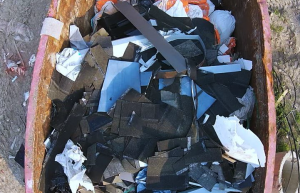Building Home Value by Reducing Construction Waste


Have you ever driven by a home construction site and noticed that big dumpster in the yard? For most, the initial impression is that it’s great to have a place to put the construction garbage to keep the jobsite looking neat and to keep the trash from blowing around. However, it’s a custom built home and what if it were your home? That 30 cubic yard dumpster is getting filled with materials that you paid for! Framing lumber, OSB, drywall, and wire are expensive and that dumpster is full of it. Not only do you have to pay to have the dumpster there and then pay to have the waste disposed of, but you paid for all the waste that is in the dumpster. That’s when it strikes you that there has to be a better way!
What is Construction Waste?
 When building anything there will be waste generated. In construction there will be cuts that have to be made leaving a board that is too short to use, drywall that needs to be cut to fit the wall it is covering, and shingles that have to be trimmed as they are being applied to the roof. There are lots of legitimate reasons that construction waste is generated.
When building anything there will be waste generated. In construction there will be cuts that have to be made leaving a board that is too short to use, drywall that needs to be cut to fit the wall it is covering, and shingles that have to be trimmed as they are being applied to the roof. There are lots of legitimate reasons that construction waste is generated.
Construction debris adds millions of tons of solid waste to landfills every year. It is made up of wood, metal, paper, and multiple petroleum based products (items such as vinyl siding, roof shingles, carpet, etc.). All of this is headed to a landfill somewhere. While residential recycling efforts by communities have helped reduce what actually ends up going to most landfills, it just hasn’t seemed to reach the traditional custom home construction industry as a whole. The EPA has estimated that waste from construction accounts for up to 40% of the solid waste in the U.S. On most home sites, there is still just a single dumpster that collects all waste in that one container to be taken and disposed of at the nearest landfill.
Site Built Homes: The Waste Maker
 According to a National Association of Home Builders (NAHB) study, an estimated 8,000 pounds of waste is created from the construction of a site built 2,000 square foot home. The majority of that 8,000 pounds is wood, cardboard, and drywall. Almost all of that waste ends up in landfills. Site construction is just inherently inefficient. Materials are dropped and left outdoors in the sun and rain. Framing lumber tends to twist and warp when left exposed for extended periods of time. Materials that are too warped or are too twisted can’t be used in the homes construction and get thrown in a dumpster.
According to a National Association of Home Builders (NAHB) study, an estimated 8,000 pounds of waste is created from the construction of a site built 2,000 square foot home. The majority of that 8,000 pounds is wood, cardboard, and drywall. Almost all of that waste ends up in landfills. Site construction is just inherently inefficient. Materials are dropped and left outdoors in the sun and rain. Framing lumber tends to twist and warp when left exposed for extended periods of time. Materials that are too warped or are too twisted can’t be used in the homes construction and get thrown in a dumpster.
Materials aren’t efficiently reused. Human nature is to take the fastest and easiest way to do something. If you need a short board, why walk to the other side of the job-site to repurpose a piece of scrap when you can cut the new board beside of you more easily. At the end of a job, lumber that is left over isn’t typically returned or reused, it is thrown in the dumpster because it just isn’t cost effective to haul to the next job-site and there isn’t enough for the lumber supplier to pick up and take as a return.
RELATED: ON THE PATH TO A ZERO ENERGY HOME: ENERGY EFFICIENT FRESH AIR
Recycling efforts for construction waste are time consuming. The cost to bring separate containers to a job-site, the labor cost to sort that waste, and the cost of trucks to haul each container away adds up. Because of the inefficiencies of building onsite, the traditional construction industry has found that it is just too expensive and inconvenient to recycle job-site waste.
Modular Homes: Green and Efficient
Modular homes allow for the responsible management of waste in construction. What this means is that there are opportunities for modular home factories to practice responsible construction more easily because construction is concentrated in one location. Modular construction is a building system and one of the goals of that system is to eliminate, minimize, or recycle construction waste.
Modular construction is great at eliminating much of the construction waste that is created in home building, to begin with. Examples include:
- Buying lumber cut to length – No need to cut and create wood waste
- Purchasing flooring pre-cut to room/home width – Efficient use of material
- Bulk Product Purchases – Reduction/elimination of packaging waste
If waste can’t be eliminated, then modular construction works to minimize it. By building indoors, water and the sun doesn’t damage wood and other construction materials. By protecting framing materials, everything delivered to the factory is actually used in a home’s construction. Framing that is delivered and considered to be substandard is either returned (cull lumber) or cut into smaller pieces to be used where appropriate. If cuts are required, the scrap is re-purposed in other areas of that home or the next home being built. For example, a scrap 16” piece of board becomes blocking for a kitchen cabinet.
 With the waste that does remain in modular construction, factories have put in place practices for the reduction, recycling, and reuse of waste items. These processes go to the heart of green construction by minimizing any waste that actually gets to a landfill. On the site of a traditionally built home, there is one dumpster for everything. In a modular home factory, there are typically 3 cubic yard dumpsters scattered on the production line. These dumpsters are used to collect waste, either for reuse or recycling. True trash, waste that will actually be sent to a landfill, is all but eliminated.
With the waste that does remain in modular construction, factories have put in place practices for the reduction, recycling, and reuse of waste items. These processes go to the heart of green construction by minimizing any waste that actually gets to a landfill. On the site of a traditionally built home, there is one dumpster for everything. In a modular home factory, there are typically 3 cubic yard dumpsters scattered on the production line. These dumpsters are used to collect waste, either for reuse or recycling. True trash, waste that will actually be sent to a landfill, is all but eliminated.
Modular Construction: Providing Value Through Responsible Waste Management
Most that have researched using modular construction for building their new custom home find many reasons that make it an attractive option. Indoor construction means water doesn’t get into the home and create mold and mildew issues while quality is enhanced because of the assembly line controls and oversight. But most never discover that one of the key reasons that modular homes can be provided at a great value is because of their leading edge material and waste management techniques.
By concentrating the construction of so many homes in one location, modular home factories are able to sustainably manage their construction waste. Everyone wins! Homebuyers get their home for a better value, landfills don’t accumulate unnecessary waste, and the factory lowers its cost of construction. Modular construction provides the environmentally responsible way to build a custom home at a great value!
The post Building Home Value by Reducing Construction Waste appeared first on Impresa Modular.




